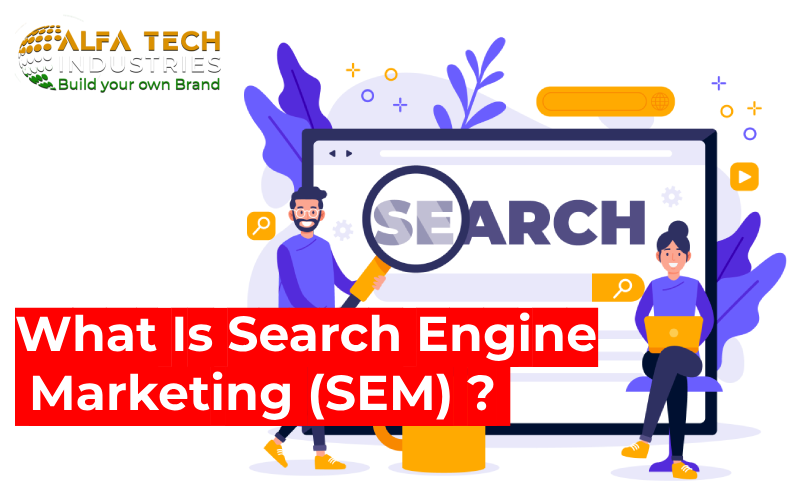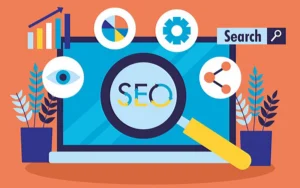
2023-09-25
Search engine marketing
Search Engine Marketing
Search Engine Marketing (SEM) is a digital marketing strategy that aims to increase a website’s visibility on search engine results pages (SERPs) through paid advertising and optimization techniques. SEM encompasses both paid search advertising (Pay-Per-Click or PPC).
Here’s a breakdown of SEM:
Paid Search Advertising (PPC): In PPC advertising, advertisers bid on keywords relevant to their products or services. When users search for these keywords, ads from the highest bidders appear at the top of the search results.
Ad Auctions: Search engines like Google and Bing use ad auctions to determine which ads appear when a user enters a search query. The ad placement is influenced by factors like bid amount, ad quality, and relevance.
Keyword Research: SEM begins with comprehensive keyword research to identify the most relevant and high-performing keywords related to the business.
Ad Creation: Advertisers create text or display ads that are engaging, relevant, and designed to entice users to click. Effective ad copy includes keywords, a compelling message, and a clear call to action (CTA).
Landing Pages: Ads typically link to specific landing pages on the advertiser’s website. These pages should be optimized for conversions, making it easy for users to take the desired action, such as making a purchase or submitting a form.
Campaign Management: Ongoing campaign management is essential to optimize ad performance. This includes adjusting bids, testing ad variations, monitoring key performance indicators (KPIs), and ensuring the campaign meets its goals.
Budgeting: Advertisers set budgets to control spending on SEM campaigns. Budgets can be set on a daily or monthly basis, and allocation depends on the campaign’s objectives and ROI targets.
Conversion Tracking: SEM campaigns track conversions to measure their effectiveness. Conversion tracking allows advertisers to see which actions users take after clicking an ad, such as making a purchase or signing up for a newsletter.
Remarketing: SEM often includes remarketing efforts, where ads are shown to users who have previously visited a website but did not complete a desired action. Remarketing aims to re-engage these users and encourage them to return.
Performance Metrics: Advertisers analyze performance metrics such as click-through rate (CTR), conversion rate, cost per click (CPC), cost per acquisition (CPA), and return on ad spend (ROAS) to evaluate campaign success and make data-driven decisions.
SEM is a powerful tool for businesses to increase online visibility, drive traffic, generate leads, and boost sales. By effectively managing PPC campaigns and optimizing their website for SEO, businesses can improve their overall online presence and reach potential customers searching for their products or services.
Importance of Search Marketing
Search marketing, which includes both Search Engine Optimization (SEO) and Pay-Per-Click (PPC) advertising, is of significant importance in the digital marketing landscape for several reasons:
Increased Visibility: Search marketing helps websites and businesses become more visible in search engine results pages (SERPs). When you optimize your website or run PPC ads, you’re more likely to appear at the top of search results, increasing the chances of attracting visitors.
Targeted Audience: Search marketing allows you to target a specific audience actively searching for products, services, or information related to your business. This means your marketing efforts are directed at users who are already interested in what you offer.
Cost-Effective: While PPC advertising involves paying for each click, it can be a cost-effective way to reach a relevant audience. You have control over your budget and can measure the ROI of your campaigns in real-time.
Measurable Results: Search marketing provides detailed data and analytics to measure the performance of your campaigns. You can track metrics like click-through rates, conversion rates, and keyword rankings, enabling data-driven decision-making and optimization.
Brand Credibility: Appearing at the top of organic search results (through SEO) or running PPC ads can enhance your brand’s credibility and trustworthiness. Users often associate top search results with reputable businesses.
Competitive Advantage: In competitive markets, search marketing can give you a competitive edge. You can outperform competitors by optimizing your website for relevant keywords and running well-targeted PPC campaigns.
Local Presence: For brick-and-mortar businesses, local SEO and PPC can help attract nearby customers. Local search marketing ensures that your business shows up in local searches and maps when potential customers are looking for nearby solutions.
User Experience: SEO efforts, such as optimizing website speed and mobile-friendliness, improve the overall user experience. This can lead to higher user engagement, longer on-site visits, and increased chances of conversion.
Adaptability: Search marketing allows you to adapt quickly to changing market conditions and user behavior. You can adjust your PPC campaigns, keywords, and SEO strategies to respond to shifts in demand and consumer trends.
Global Reach: For businesses with a global audience, search marketing enables you to reach an international market. Multilingual SEO and geo-targeted PPC campaigns can help expand your reach.
Lead Generation and Sales: Search marketing is an effective lead generation tool. It can drive qualified leads to your website, and with the right conversion optimization strategies, convert those leads into customers or clients.
Long-Term Strategy: SEO, when done right, can provide lasting benefits. Once your website ranks well for specific keywords, it can maintain its position over time with ongoing maintenance and updates.
Search Marketing Types
Search marketing encompasses various types and strategies that businesses can use to improve their online visibility and attract relevant traffic from search engines. Here are some key types of search marketing:
Search Engine Optimization (SEO):
On-Page SEO: Enhancing the search engine rankings of individual web pages through optimization. This includes headings, optimizing content, meta tags, and images.
Technical SEO: Enhancing the technical aspects of a website, such as site speed, mobile-friendliness, and crawlability, to improve search engine rankings.
Local SEO: Optimizing a website to appear in local search results, especially for businesses targeting a local audience. This includes creating and managing Google Business listings.
Pay-Per-Click Advertising (PPC):
Google Ads: Creating and running paid advertising campaigns ( PPC ) on Google’s search and display networks.
Bing Ads: Similar to Google Ads, Bing Ads allows advertisers to create paid search advertising campaigns on the Bing search engine.
Social Media Advertising: Running paid advertising campaigns on social media platforms like Facebook, Instagram, Twitter, and LinkedIn. These ads can target specific audience and interests.
Content Marketing:
Blogging: Creating and regularly updating a blog with high-quality, informative, and engaging content that can rank well in search results and attract organic traffic.
Content Optimization: Optimizing existing content for search engines by incorporating relevant keywords, improving readability, and ensuring proper formatting.
Guest Posting: Writing and publishing content on other authoritative websites in your industry to build backlinks and increase brand visibility.
Video Marketing:
YouTube SEO: Optimizing video content on YouTube to rank higher in search results and attract views. This includes using tags, descriptive titles, and descriptions.
Video Advertising: Running paid video ads on platforms like YouTube and other video-sharing sites.
Voice Search Optimization:
Voice-Friendly Content: Creating content that answers common voice search queries, as voice search becomes more prevalent with the rise of virtual assistants like Siri and Alexa.
Local Voice SEO: Optimizing for voice search queries related to local businesses and services.
E-commerce Optimization:
Product Listing Ads (PLAs): Creating and optimizing product listings on e-commerce platforms like Google Shopping to showcase products to potential buyers.
Shopping Feeds: Managing product data feeds to ensure accurate and up-to-date information for online shoppers.
Mobile Search Optimization:
Mobile SEO: Ensuring that websites are mobile-friendly and load quickly on mobile devices, as mobile search is increasingly important.
Mobile Apps: Optimizing mobile apps for app store search and visibility.
App Store Optimization (ASO):
ASO Keywords: Choosing relevant keywords for app store listings to improve app visibility in app store search results.
App Reviews and Ratings: Encouraging positive user reviews and ratings, as these can influence app store rankings.
These are some of the key types of search marketing that businesses can utilize to enhance their online presence and attract targeted traffic from search engines and other digital platforms. The choice of search marketing strategies depends on the specific goals and target audience of a business.
Best SEM tools
The choice of SEM (Search Engine Marketing) tools can significantly impact the effectiveness of your SEM campaigns. Here are some of the best SEM tools and platforms widely used by digital marketers:
Google Ads (formerly Google AdWords): Google Ads is the most popular and widely used PPC advertising platform. It offers a comprehensive suite of tools for keyword research, ad creation, campaign management, and performance tracking. Google Keyword Planner is a valuable tool within Google Ads for keyword research.
Bing Ads: Bing Ads is Microsoft’s PPC advertising platform and is often used in conjunction with Google Ads to reach a broader audience. It provides similar features for keyword research, ad creation, and campaign management.
SEMrush: SEMrush is an all-in-one SEM tool that offers features for keyword research, competitive analysis, backlink analysis, site audit, and more.
Ahrefs: Ahrefs is primarily known for its comprehensive backlink analysis tools, but it also offers features for keyword research and rank tracking. It’s valuable for both SEO and PPC campaigns.
WordStream: WordStream is a PPC management platform that offers a range of tools for keyword research, ad creation, and campaign optimization. It includes features like the Keyword Niche Finder and the Ad Text Optimizer.
SpyFu: SpyFu is a competitive research tool that helps you spy on your competitors’ PPC campaigns. It provides data on the keywords they bid on, their ad copy, and their budget estimates.
Optmyzr: Optmyzr is a PPC management and optimization platform that offers features like automated bidding, ad scheduling, and ad testing. It streamlines campaign management tasks and provides data-driven insights.
Kenshoo: Kenshoo is a comprehensive marketing platform that includes tools for SEM, social advertising, and e-commerce. It’s often used by larger enterprises and agencies for advanced SEM campaigns.
AdRoll: AdRoll specializes in retargeting and display advertising. It helps you create and manage retargeting campaigns across various channels to re-engage website visitors.
Google Analytics: While not a dedicated SEM tool, Google Analytics is essential for tracking and analysing the performance of your SEM campaigns. It provides valuable insights into user behaviour, conversion tracking, and ROI measurement.
Facebook Ads Manager: If you’re running SEM campaigns on Facebook and Instagram, Facebook Ads Manager is the go-to platform for campaign setup, audience targeting, and ad creation.
LinkedIn Campaign Manager: For B2B-focused SEM campaigns, LinkedIn Campaign Manager allows you to create and manage ads on the LinkedIn platform, targeting specific professional audiences.
The choice of SEM tools depends on your specific needs, budget, and the scale of your campaigns. Many marketers use a combination of these tools to achieve their SEM goals, leveraging the strengths of each platform for different aspects of their campaigns.
What is the main goal of Search Marketing?
The main goal of Search Marketing is to improve a website’s visibility in search engine results pages (SERPs) and attract targeted traffic from search engines like Google, Bing, and Yahoo. This goal can be further refined into several specific objectives, including:
Increasing Website Traffic: Search marketing aims to drive more users to a website by achieving higher rankings for relevant search queries. The ultimate goal is to attract users who are actively searching for products, services, or information related to the website’s offerings.
Generating Leads and Conversions: Beyond traffic, search marketing strives to convert visitors into leads or customers. This could involve actions such as making a purchase, filling out a contact form, subscribing to a newsletter, or downloading a resource.
Enhancing Brand Visibility and Awareness: Being prominently featured in search results can boost a brand’s recognition and credibility. Even if users don’t immediately convert, they may become more aware of the brand, which can influence future decisions.
Competing Effectively: In competitive markets, search marketing helps businesses stay competitive by ensuring their online presence is strong and competitive. It allows them to vie for a share of the market and reach potential customers before competitors do.
Targeting Specific Audiences: Search marketing enables businesses to target specific demographics, locations, and user behaviours. This ensures that marketing efforts are focused on the most relevant and potentially high-converting audiences.
Measuring and Optimizing Results: Search marketing provides the advantage of measurable results. Marketers can track key performance indicators (KPIs) such as click-through rates (CTR), conversion rates, and return on investment (ROI). These metrics allow for data-driven decisions and ongoing optimization.
Adapting to User Behaviour: Search marketing strategies can adapt to changes in user behavior and search engine algorithms. For example, optimizing for mobile search and voice search is crucial as more users engage with search engines through these methods.
Local and Mobile Visibility: For businesses with physical locations or targeting mobile users, search marketing ensures visibility in local search results and mobile searches.
Providing Valuable Content: As part of search marketing, businesses often create high-quality and informative content to address users’ needs and questions. This contributes to a positive user experience and builds trust.
Maximizing ROI: Search marketing allows businesses to allocate their budgets efficiently. By measuring the ROI of campaigns and adjusting strategies accordingly, they can maximize their return on investment.
In essence, the main goal of search marketing is to connect businesses with their target audience by making their online presence highly visible and relevant in search engine results. Achieving this goal involves a combination of strategies, including Search Engine Optimization (SEO), Pay-Per-Click (PPC) advertising, content creation, and ongoing optimization efforts.
Conclusion
In conclusion, Search Engine Marketing (SEM) is a vital and dynamic component of the digital marketing landscape. Its primary goal is to enhance a website’s visibility in search engine results pages (SERPs) and drive targeted traffic, ultimately leading to increased brand exposure, engagement, and conversions.
SEM encompasses a range of strategies and techniques, including Search Engine Optimization (SEO) to improve organic rankings and Pay-Per-Click (PPC) advertising for immediate visibility. This multifaceted approach allows businesses to adapt to changing user behavior, market trends, and algorithm updates.
The importance of SEM lies in its ability to connect businesses with users actively seeking their products or services, ensuring that marketing efforts are highly relevant. Moreover, SEM offers precise targeting options, measurable results, and the flexibility to adjust campaigns in real-time, making it a valuable tool for businesses of all sizes and industries.
As the digital landscape continues to evolve, search marketing remains a cornerstone of effective online marketing strategies. Its ability to drive qualified traffic, generate leads, and optimize ROI makes it an indispensable tool for businesses striving to succeed in the highly competitive online marketplace. To leverage the full potential of SEM, businesses should stay informed about industry trends, adhere to best practices, and consistently monitor and refine their campaigns for continued success.
Frequently Asked Questions:
What is Search Engine Marketing (SEM)?
SEM is a digital marketing strategy that involves promoting websites and businesses through paid advertising (PPC) and optimization techniques to improve their visibility in search engine results pages (SERPs).
How does SEM differ from SEO?
SEM includes both paid advertising (PPC) and optimization efforts, while SEO focuses solely on optimizing a website to improve organic (unpaid) search rankings.
What are some popular SEM platforms for PPC advertising?
Google Ads (formerly Google AdWords) and Bing Ads are among the most widely used platforms for PPC advertising.
What is the main goal of SEM?
The primary goal of SEM is to increase a website’s visibility in search results, attract targeted traffic, and achieve specific marketing objectives such as lead generation, conversions, and brand exposure.
How does PPC advertising work in SEM?
In PPC advertising, advertisers bid on keywords and pay a fee each time a user clicks on their ad. Ads are displayed when relevant keywords are searched, and the ad position is influenced by bid amount, ad quality, and other factors.
What is the role of keyword research in SEM?
Keyword research helps identify relevant keywords and phrases that users commonly search for. It informs the creation of ad campaigns and content optimization efforts.
What is the importance of landing pages in SEM?
Landing pages are crucial in SEM because they are where users are directed after clicking on ads. Effective landing pages are designed to encourage conversions by providing relevant information and a clear call to action.
How can I measure the success of my SEM campaigns?
Success in SEM is typically measured using key performance indicators (KPIs) such as click-through rate (CTR), conversion rate, cost per click (CPC), cost per acquisition (CPA), and return on investment (ROI).
Is SEM suitable for all types of businesses?
SEM can be effective for a wide range of businesses, but its suitability depends on factors such as the target audience, budget, and marketing goals. It may not be the best fit for all marketing objectives.
What is remarketing in SEM?
Remarketing involves showing ads to users who have previously visited your website but did not convert. It aims to re-engage these users and encourage them to take action.



